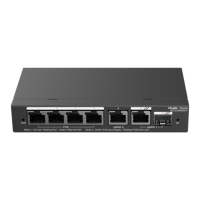CLI Reference Network Connectivity Test Tool Configuration Commands
The ping command can be used in the ordinary user mode and the
privileged EXEC mode. In the ordinary mode, only the basic functions
of ping are available. In the privileged EXEC mode, in addition to the
basic functions, the extension functions of the ping are also available.
For the ordinary functions of ping, five packets of 100Byte in length
are sent to the specified IP address within the specified period (2s by
default). If response is received, „!‟ is displayed. If no response is
received, „.‟ displayed, and the statistics is displayed at the end. For
the extension functions of ping, the number, quantity and timeout time
of the packets to be sent can be specified, and the statistics is also
displayed in the end. To use the domain name function, configure the
domain name server firstly. For the concrete configuration, refer to
the DNS Configuration section.
The example below shows the ordinary ping.
Ruijie# ping 192.168.5.1
Sending 5, 100-byte ICMP Echoes to 192.168.5.1, timeout
is 2 seconds:
< press Ctrl+C to break >
!!!!!
Success rate is 100 percent (5/5), round-trip min/avg/max
= 1/2/10 ms
The example below shows the extension ping.
Ruijie# ping 192.168.5.197 length 1500 ntimes 100 timeout
3
Sending 100, 1500-byte ICMP Echoes to 192.168.5.197,
timeout is 3 seconds, data ffff source 192.168.4.10:
< press Ctrl+C to break >
!!!!!!!!!!!!!!!!!!!!!!!!!!!!!!!!!!!!!!!!!!!!!!!!!!!!!
!!!!!!!!!!!!!!!!!!!!!!!!!!!!!!!!!!!!!!!!!!!!!!!
Success rate is 100 percent (100/100), round-trip
min/avg/max = 2/2/3 ms
Ruijie#
The command is supported by all equipments.
ping ipv6
Use this command to test the connectivity of a network to locate the network connectivity problem. The command
format is as follows:
ping [ipv6] [ipv6-address [length length ] [ntimes times] [timeout seconds] [data data]
[source source]
Specifies an IPv6 address.
Specifies the length of the packet to be

